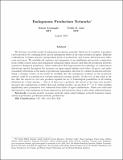Endogenous Production Networks
Author(s)
Acemoglu, K. Daron; Azar, Pablo Daniel
DownloadAcemoglu_Endogenous_production_networks.pdf (721.2Kb)
Open Access Policy
Open Access Policy
Creative Commons Attribution-Noncommercial-Share Alike
Terms of use
Metadata
Show full item recordAbstract
We develop a tractable model of endogenous production networks. Each one of a number of products can be produced by combining labor and an endogenous subset of the other products as inputs. Different combinations of inputs generate (prespecified) levels of productivity and various distortions may affect costs and prices. We establish the existence and uniqueness of an equilibrium and provide comparative static results on how prices and endogenous technology/input choices (and thus the production network) respond to changes in parameters. These results show that improvements in technology (or reductions in distortions) spread throughout the economy via input–output linkages and reduce all prices, and under reasonable restrictions on the menu of production technologies, also lead to a denser production network. Using a dynamic version of the model, we establish that the endogenous evolution of the production network could be a powerful force towards sustained economic growth. At the root of this result is the fact that the arrival of a few new products expands the set of technological n products, the arrival of one more new product increases the combinations of inputs that each existing product can use from 2 (superscript n−1) to 2 (superscript n) thus enabling significantly more pronounced cost reductions from choice of input combinations. These cost reductions then spread to other industries via lower input prices and incentivize them to also adopt additional inputs.
Date issued
2020-01Department
Sloan School of Management; Massachusetts Institute of Technology. Department of EconomicsJournal
Econometrica
Publisher
Econometric Society
Citation
Acemoglu, Daron and Pablo D. Azar. "Endogenous Production Networks." Econometrica 88, 1 (January 2020): 33-82.
Version: Author's final manuscript
ISSN
0012-9682